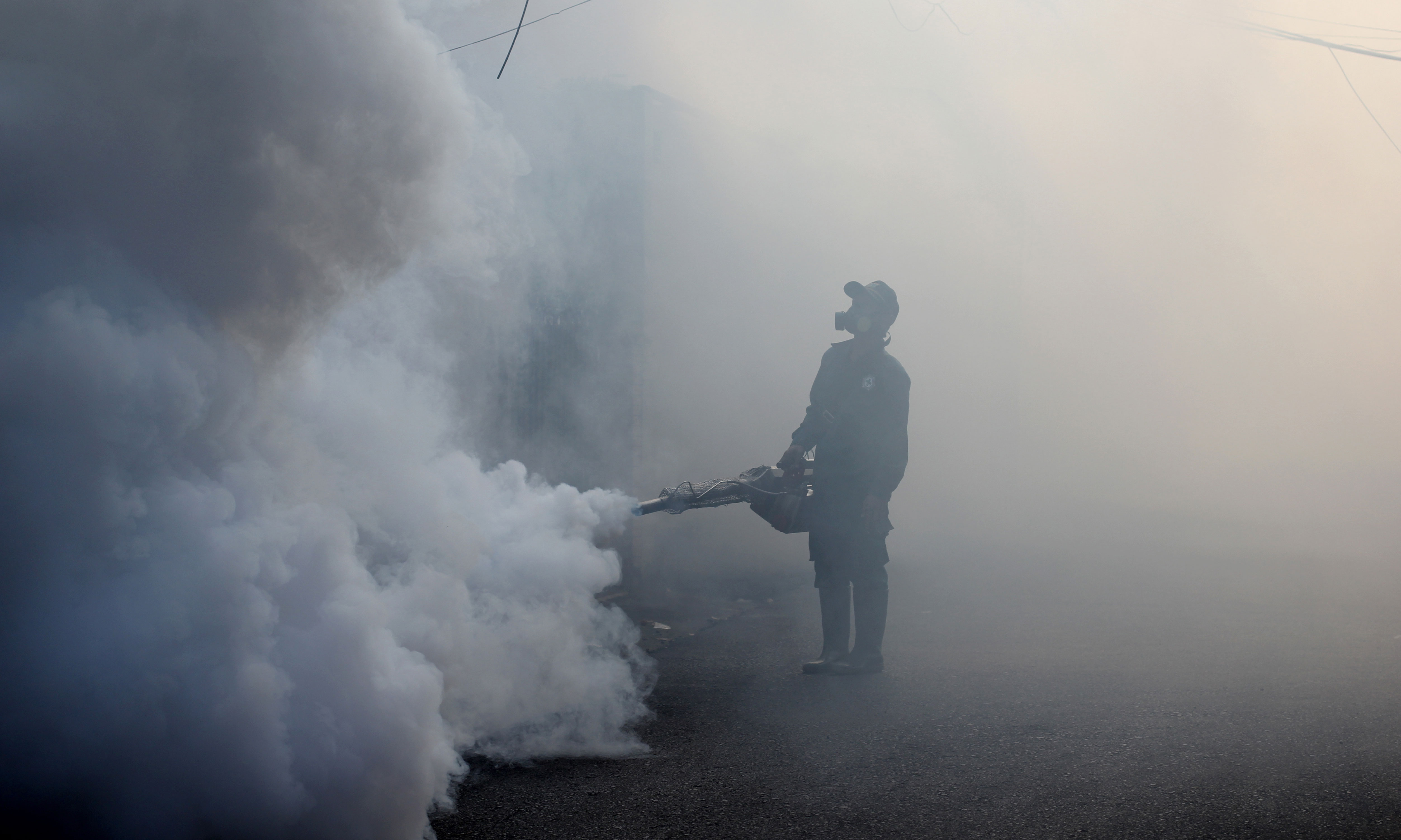Jean-Baptiste Say, Cours complet d’économie politique (Paris: Guillaume, 1828).
Jeffrey R. Powell and Walter J. Tabachnick, “History of Domestication and Spread of Aedes Aegypti: A Review,” in Memórios do Instituto Oswaldo Cruz 108 (2013): 11–17.
L.C. Harrington, J.D. Edman, and T.W. Scott, “Why Do Female Aedes Aegypti (Diptera: Culicidae) Feed Preferentially and Frequently on Human Blood?” Journal of Medical Entomology 38 (2001): 411–422.
Jim Robbins, “How Forest Loss is Leading to a Rise in Human Disease,” Yale Envirionment 360 (23 February, 2016), ➝.
Manuel DeLanda, “Inorganic Life,” Zone 6: Incorporations, eds. Jonathan Crary and Sanford Kwinter (New York: Zone Books, 1992): 149–150.
World Health Organization, “Dengue and Severe Dengue,” ➝.
S. Sim, J.L. Ramirez, and G. Dimopoulos, “Dengue Virus Infection of the Aedes Aegypti Salivary Gland and Chemosensory Aparatus Induces Genes That Modulate Infection and Blood-feeding Behavior,” PLoS Pathogens 8 (2012).
Ibid., Powell and Tabachnick.
The first dengue vaccine, Dengvaxia, was approved by the WHO in April 2016. As of August 2016, Mexico, Brazil, The Philippines, and El Salvador also licensed the vaccine. The cost and a concern that the vaccine will not protect against all strains of the virus have caused many of the 128 dengue-endemic countries to abstain from vaccine purchasing and implementation.
Adrienne Lafrance, “Genetically Modified Mosquitoes: What Could Possibly Go Wrong?” The Atlantic (26 April 2016), ➝.
This poem was written by Ross the night he first discovered that mosquitoes transmit malaria.
Eight annas have a value of less than one US cent.
Robert E. Sinden, “Malaria, Mosquitoes, and the Legacy of Ronald Ross,” Bulletin of the World Health Organization Volume 85, Number 11 (November, 2007): 821–900, ➝.
H. Graham, “Researches on Dengue,” Journal of the American Medical Association 41 (1903).
Peter Sloterdijk, Terror from the Air (Los Angeles: Semiotext(e), 2009), 28.
Ibid., 14.
Ibid., 16.
Donna J. Haraway, Staying with the Trouble: Making Kin in the Chthulucene (Durham: Duke University Press, 2016), 61.
Scott C. Miller and Nikos Vasilakis, “Molecular Evolution of Dengue Viruses: Contributions of Phylogenetics to Understanding the History and Epidemiology of the Preeminent Arboviral Disease,” Infection, Genetics, and Evolution 9 (2009): 157–170.
S.S. Twiddy, E.C. Holmes, and A. Rambout, “Inferring the Rate and Time Scale of Dengue Virus Evolution,” Molecular Biology and Evolution Journal 20 (2003): 122-129.
World Health Organization, “Dengue and Severe Dengue” (July 2016), ➝.
Isabelle Stengers, In Catastrophic Times: Resisting the Coming Barbarism (London: Open Humanities Press / Meson Press, 2015), 54.
Pyrethroids have been the pesticide of choice for nearly twenty years in Indonesia, replacing organophosphates, which were shown to have negative human and environmental health impacts after thirty years of use. The discovery of DDT’s endocrine disrupting effects and subsequent ban initiated the development of pyrethroids, which are heralded by pesticide companies and government alike as the safer options for non-mosquito beings (despite their acute toxicity to fish, bees, dragonflies, cats, and sometimes dogs), while still offering a mortal mosquito knock-down. See Iqbal R.F. Elyazar, Simon I. Hay, and J. Kevin Baird, “Malaria Distribution, Prevalence, Drug Resistance and Control in Indonesia,” Journal of Advanced Parasitology 74 (2011): 41–175.
See Damar Tri Boewono, “Susceptibility of Dengue Haemorrhagic Fever Vector (Aedes Aegypti) Against Organophosphate Insecticides (Malathion and Temephos) in Some Districts of Yogyakarta and Central Java Provinces,” Bulletin Penelitian Kesehatan 35 (2007); and, Kris Cahyo Mulyatno, Atsushi Yamanaka, and Eiji Konishi Ngadino, “Resistance of Aedes Aegypti (L.) Larvae to Temephos in Surabaya, Indonesia,” Southeast Asian Journal of Tropical Medicine and Public Health 43 (2012): 29–33.
Jakarta Provincial Law No 6/2007, “Dengue Hemorrhagic Fever Control.”
Juli Rochmijati Wulandari, Siu Fai Lee, Vanessa Linley White, Warsito Tantowijoyo, Ary Anthony Hoffman, and Nancy Margaret Endersby-Harshman, “Association Between Three Mutations, F1565C, V1023G, S996P, in the Voltage-Sensitive Sodium Channel Gene and Knockdown Resistance in Aedes Aegypti from Yogyakarta, Indonesia,” Insects 6 (2015): 658–685.
Aedes aegypti had a head start building resistance from decades of exposure to DDT, which targets the same channel. Mosquitoes were shown to be resistant to DDT just four years following their use; see Sayono Sayono, Anggie Puspa Nur Hidayati, Sukmal Fahri, Didik Sumanto, Edi Dharmana, Surharyo Hadisaputro, Puji Budi Setia Asih and Din Syafruddin, “Distribution of Voltage-Gated Sodium Channel (Nav) Alleles Among the Aedes Aegypti Populations in Central Java Province and its Association with Resistance to Pyrethroid Insecticides,” PLoS One 11 (2016).
Kaliyaperumal Karunamoorthi and Shanmugavelu Sabesan, “Insecticide Resistance in Insect Vectors of Disease with Special Reference to Mosquitoes: A Potential Threat to Global Public Health,” Health Scope 2, no. 1 (2013): 4–18.
Heat also helps things get and stay moving: the rising temperatures that provide local indices to climate change also speed up Aedes Aegypti development and rapidly alter its behavior; every stage in their life cycle is condensed when incubated in heat, and warmer temperatures make Aedes Aegypti hungrier for blood.
Ibid., Sloterdijk, 28.
Saleha Sungkar, “Controlling the Dengue Vector: What’s the Problem?”, public lecture in the Faculty of Medicine, Universitas Indonesia (June 2016).
Judith Butler, Notes Toward a Performative Theory of Assemblage (Cambridge: Harvard University Press, 2015).
Ibid., Sloterdijk, 99.
Timothy Mitchell, Rule of Experts: Egypt, Techno-Politics, Modernity (Berkeley: University of California Press, 2002), especially 19–53.
Beatriz Colomina and Mark Wigley, Are We Human? Notes on an Archaeology of Design (Zurich: Lars Muller Publishers, 2016), 141.
The research which led to this publication was made possible by grants from the University of Pittsburgh and the NTU Centre for Contemporary Art Singapore. Specials thanks to the many researchers who helped conduct or supported this preliminary research, especially Christina Geros, Nashin Mahtani, Pritta Andrani, Mahardika Fadmastuti, Elise Hunchuck, and Frank Sedlar; thanks also to Richard Pell of the Center for PostNatural History for facilitating these and other postnatural encounters.
